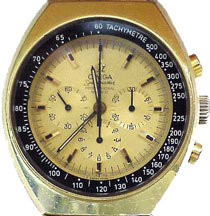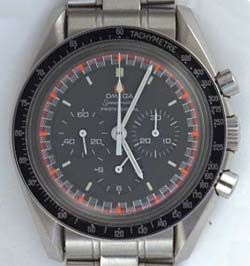 - Written by
Chuck
Maddox
 on 28 December 1999,
on 28 December 1999,
- Last Revised:
21 May 2006, 16:16 GMT
- certain
rights reserved.

The Speedmaster Mark
Series consists of four distinct different "Marks"
that in some cases (pardon the pun) spawned their own
offshoots. The first of the "Marks", which is almost
never referred to as the Mark I, is the original Omega
Speedmaster commonly referred to as the moonwatch in
c.861. Apparently, Omega for some reason decided to
either: a) begin to phase out the moonwatch
case in favor of the Mark II or b) to offer the
Mark II as an alternative. Perhaps Omega was planning
on distinguishing between the c.321 and c.861 by
naming the c.861 Mark I, but this is
speculation on my part which typically bears
little or no resemblance to reality.
Here is a brief run down on
the cases and movements of the Marks:
Omega
Speedmaster Professional Mark II
(1969):

|

|
|
Click
on photo to access a 1,280 x 1,028
Scan
|
Click
on photo to access a 1,280 x 1,028
Scan
|
|
|
|
The Speedmaster Professional
Mark II was introduced in 1969 and marks the first
departure from the main moonwatch line to have been made
available to the general public. This model along with
the Mark IV are the only models of the Mark Series to
consistently have the Professional moniker... Only some
Mark III's and no Mark V's are marked "Professional",
while all Mark II's and Mark IV's are. I will discuss
specifics on this further along in the appropriate
sections...
The Mark II was produced in
three main variants:
- Black dialed
Stainless Steel Cased version that looks very close to
the Moonwatch. (Ref. ST145.014)
- Black dialed
SS case version with Orange/Red/Gray coloring along
the minute track. (Ref. ST145.014)
- Gold dialed
Gold case version with a Maroon Tachy ring. (Ref.
MD145.034)
- All three variants used
the same c.861 movement as found in the c.861
Speedmaster Professional (moonwatch) of the same
vintage. Although to my knowledge the Mark II was not
ever submitted for NASA Flight testing it supposedly
was intended as a eventual replacement of the
Moonwatch case from what I've read.
-
- However,
on this point Owain Blackwell of the United Kingdom
forwarded me the following dialog he had via email
with Jean-Luc Miranda, Omega Museum, Vintage
Information, after contacting Omega on this
point:
- "Dear
Sir/Madam,
- I would be most
grateful if you could help me answer the following
three questions that have been puzzling me. Re:
Speedmaster Professional Mark II
(1). When this was
introduced in 1969 was it originally intended the
supersede the 'Mark I' or simply to be an alternative?
The Mark II is the first model of the "MARK" Series,
there is no Mark I
- Response:
The Mark II is the first model of the "MARK"
Series, there is no Mark I
- [Although
on rare occasions, collectors have referred to
the main "moonwatch" Speedmaster line as "Mark
I" Speedmasters...]
(2). When it was
designed did the designers have its use on future
Apollo space programmes in mind?
- Response:
Difficult to say but we know that in February 1969
our US Agent and our Sales Manager paid a visit to
the NASA in Houston and proposed the Mark II as an
alternative to the already in use and most
appreciated "moon watches". This proposal was
denied because the Apollo program had tight
schedules and that it would have taken too much
time to the NASA to get the official approval from
the Test Division.
(3). The terms 'Mark'
in a series usually suggests that improvements are
being made with each succeeding mark. Where the
improvements (ie mineral crystal, water resistance)
made with the Space programme in mind?
- Response:
These improvement were brought to
several watches of the same period, not specially
having the space program in mind..
-
- Thanks to Owain for
doing the leg work on the topic of of Mark II's and
NASA!
Of the three variants of
the Mark II they are listed above in order of apparent
rareness. One of the things that may not be immediate
noticable on a Mark II is that while it is a handsome
watch on a Bracelet because of it's large and thick
case it looks a bit odd on a leather strap.
Fortunately it is possible to get a suitable Omega
Bracelet for at least the stainless steel versions of
these watches with a little bit of foot
work.
-

|
- Red/Orange/Gray
Omega Speedmaster Professional Mark
II
--
Photo by Ruckdee C.
|
- However, in doing
research for this article, I located a fourth variant
that I had forgotten about... This variant has an
unusual multicolored minute ring instead of the usual
Tachy ring. A showcase of these variants
follows:
-
-
- It is important to note
that it is possible to change the bezel with factory
produced alternatives (such as a pulseometer) and
still be a genuine product. The "Funky" Mark II
(Number
4 above) is the
only example I've seen of this particular variation.
There is a nice short article on Bezel Inserts for the
Moonwatch Speedmasters on TimeZone
Classic Number 876
written by Bo Hansen. I should also mention a short
article I composed for an article
on the Speedmaster 125
that explains How
to use four different types of chronograph
bezels...
Finally, I have a picture of a Mark II Styled c.1045
that has a Pulseometer Bezel as shown below to
illustrate the possibility of doing this.
-

|
- Omega
Speedmaster c.1045 w/Pulsation Dial
- This
is not a Mark II or Mark IV!!!
|
-
-

|
Omega
Speedmaster Professional Mark II,
--
Photo by Mike V.
|
- Recently, eieioeieio
emailed me a series of photo's of his Red/Orange Mark
II... Vincent's example is as clean of an example as
I've ever seen, and he has granted me permission to
include those photo's here:
-
      - This is about as good as
it get's folks! Thanks again
eieioeieio for your
scans and your permission!
- Commentary on the
Mark II's: The Mark II is the most commonly
seen of the Mark Series by a goodly amount. The black
dialed Speedmaster being the most common of the
common. The Red/Orange/Gray dialed version be
somewhat less commonly seen. The Gold version
is even rarer. I don't know if the Gold version is
simply gold plate, or gold filled (or 14k/18k) but the
caseback on these models is Stainless Steel...
Although I have never seen one so equipped it would be
a relatively simple matter to put a black bezel
crystal onto the Gold edition which came with a Red or
Maroon Bezel, which I would think would be an
attractive combination. I should mention that my first
Omega and first quality Swiss watch was a Black Dial
Speedmaster Mark II Professional. A watch I still hold
dear. I recently restored that Mark II and the story
of it's restoration is located here:
Speedmaster
Professional Mark II: Reborn...
Omega Speedmaster Mark III Automatic / Professional -
Automatic (1971~1973):
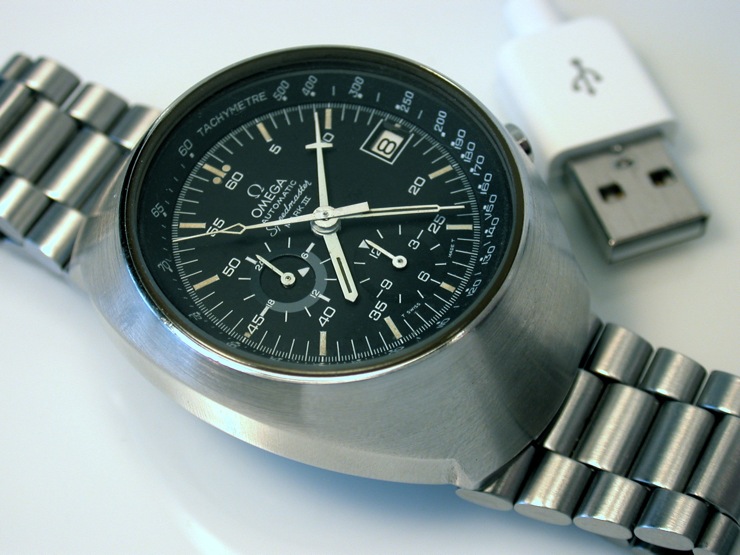
|
|
Click
on photo to access a 1,280 x 960 pixel
Scan
|
- The Mark III is an odd
bird. In 1972, Lemania and Omega presented their
jointly developed caliber 1040a central rotor winding
automatic chronograph with a diameter of
13 3/4 lines, and a height was 8 mm.
The Mark III marks the first use of this movement in
an Omega watch. The Omega c.1040 movement is a
non-chronometer rated movement. However in 1973 after
some fine tuning the chronometer grade c.1041 movement
used in the Speedmaster 125 Anniversary Chronograph
would be produced.. Both Omega Calibre 1040 and 1041
are also known as the Lemania Calibre 1341. The 125
marked Omega's first Chronometer Chronograph, and was
the first chronometer grade automatic chronograph. a
precursor to the current Seamaster Professional
Chronograph-Chronometer, although the movement has
little in common with the current model Seamaster The
Mark III is the only one of the Mark Series to have
three very distinctive case styles, the second of
which has a very similar model in the Seamaster
series. Hence I have classified them as Mark III(a)
and Mark III(b) and Mark III(c). The Mark III(a) is
also available in at least three different dial
combinations:
-
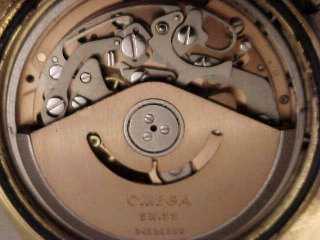
|
Omega
c.1040 Movement used in the Speedmaster Mark
III and Mark IV
|
- Mark
III(a) Variants (Flightmaster-Style Case):
- A Black
dialed Stainless Steel similar in appearance to the
aforementioned ST 145.014 Mark II and the Moonwatch
(Ref. ST176.002) from 1973, but in a modified
Flightmaster Styled case.
- A Navy Blue
Dialed/White Sub-dialed Stainless Steel case with a
Gray Tachy Ring, also (Ref. ST176.002) from
1973.
- A Silver
dialed Stainless Steel model with a medium blue
Tachy Ring, also (Ref. ST176.002) but listed in the
Time Capsule book as dating from 1973.
- Mark
III(b) Variants (Seamaster-Style Case):
- The Mark III(b)
Variant is also an odd bird in that I have seen
listed in both Stainless Steel and Gold versions on
line numerous times, but neither version I have
seen shows up in the Time Capsule book. I have seen
enough of these to believe they are not fakes or
custom made versions. A picture I have cobbled
together of a Mark III(a) and a MarkIII(b) side by
side follows:

|
- Omega
Speedmaster Mark III: Variant Mark
III(a) at left, and Variant Mark III(b)
at right.
- The
author owns the Mark III(a) at
left.
|
- In addition to the
Blue dialed variant pictured above right, the Mark
III(b) Variant was also available in a Gold/Gold
Case/Dial version as well. Additionally, Omega made
a number of Seamaster models with
this same basic case and dial layout. A picture of
one of my Seamaster examples
follows:
-
 -
- Mark III(c)
Variants (Square Dial Seamaster
Case):
-
- The Mark III(c)
Variant is also unusual in that it shares a case
with a Seamaster of the same vintage.
|

|
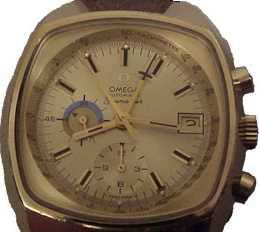
|
|
(At
Left) The Speedmaster Mark III, variant (c)
Reference number 176.005 manufactured in 1972
from the Time Capsule Book. (Above) A Gold
case/Gold Dial c.1040 Seamaster also
roughly from the same era. You might not
believe it but these two watches are from
different lines within the Omega
Family!
|
|
Two
of my Stainless Steel Seamasters with
this style case are pictured below. There
seem to be greater availability of this
particular case in Seamaster trim than
Speedmaster
|

|

|
|
As you can
see the Seamaster TV Dial's were offered in a
number of different dial
configurations...
|
- Is
the Mark III a "Professional" or not?
-
- One of the more
interesting facts about the Mark III is that it was
offered both as "Omega Automatic Speedmaster Mark III"
and as the "Omega Speedmaster Professional Mark III
Automatic" as indicated on the dial, at least in the
Mark III(a) variant. An email correspondence with John
Diethelm of Omega Vintage information yielded the
following information: "existing in one and unique
reference: ST 176.0002 - Calibre 1040 - automatic
chronograph" and that "°ref. ST 176.0002 =
we have surely one and unique reference for this
watch, but in 1971, when launched, this watch had a
dial " without the name... Professional " these names
have only been added to the versions produced after
1973, which is therefore a Seamaster " Speedmaster "
chronograph automatic Mark III (automatic at 3 hours !
)"...
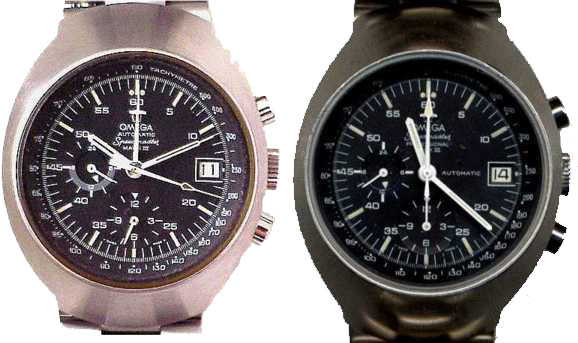
|
- Omega
Automatic Speedmaster Mark III
- (1971-1972)
|
- Omega
Speedmaster Professional Mark III
- Automatic
(1973-)
|
- Thus, it appears that
early Mark III(a)'s manufactured during 1971 and 1972
sport the "Omega Automatic Speedmaster Mark III dial
with no reference to "Professional" (pictured above on
the left), while Mark III's manufactured during 1973
and thereafter feature the "Omega Speedmaster
Professional Mark III Automatic" dial as pictured
above at right... I have yet to see a Mark
III(b) or a Mark III(c) marked as "Professional". This
is not to say that they don't exist, but until I see
to the contrary, it appears that only the Mark III(a)
have this variability, being marked as
"Professional"...
-
- Mark
III Instruction Manual
These scans are from a
Mark III Directions booklet. They can be used not only
for the Speedmaster Professional Mark III Automatic
and Speedmaster Mark III Automatic, but also any Omega
Chronograph utilizing the Lemania 1342 base movement.
These include the Speedmaster Professional Mark IV,
Speedmaster 125, and several different Seamaster
Automatic models.
 - Clicking
on the picture will open a new window with a 1280 x
800 pixel version of the picture
 - Clicking
on the picture will open a new window with a 1280 x
800 pixel version of the picture
-
- Commentary on the
Mark III's: The Mark III(a) case is
probably the thickest watch I own. At 17mm or .65625
inches, it's very tall, but it has an unusual
high-tech look to it that I find very appealing. My
example has been nicknamed "Dr. Evil" by me as it
reminds me of the sweet spot of the Bond movies (from
Goldfinger through On Her Majesties Secret Service) as
well as the Austin Powers movies that were inspired by
these films, as a watch that would show up on the
wrist of a character in one of those movies... I do
not own an example of the other variants, nor are they
on my acquisition list, as I do not find them as
attractive as the Black Dialed Mark III(a). It is not
that they aren't appealing, just that they don't
appeal to me that much. The Mark III(a) and the Mark
III(b) while less common than the Mark II are fairly
common, the Mark III(c) seems to be considerably less
common.
-

|
|
Click
on photo to access a 1,280 x 1,028
Scan
|
-
Omega
Speedmaster Professional Mark IV
(1973):

|
|
Click
on photo to access a 1,280 x 960 pixel
Scan
|
- The Mark IV, along with
the Mark II are marked "Professional" on the dial. The
Speedmaster 125, the Mark V, the c.1045 Speedmaster's,
and some Mark III's also do not rate "Professional"
status.
-
- Initially
I had thought that there was only one variant of the
Mark IV made by Omega. But not too long after my
initial posting of this article Jussi Peltola, a
Finnish Mark IV Speedmaster owner pointed out a
variant on a site in Denmark that differs from the
published pictures in the Time Capsule book and from
what I have seen previously on the web. Hence I have
named the more common and published variant as a Mark
IV(a), and the Danish variant a Mark IV(b). As I
haven't seen this variant in-person and hence cannot
confirm it's authenticity, At the moment I will
assume that it is a genuine product offered by
Omega although it may not.
Both of the Mark IV
variants use a c.1040 movement (2-Register) watch
based off of the Speedmaster 125 movement (like the
Mark III). The Mark IV(a) uses a variant of the Mark
II case with the Bezel being slightly modified to
handle the extra thickness of the c.1040 movement.
While the Mark IV(b) appears to use the same case as
the Mark
III(b). Why Omega
choose to do this is somewhat mysterious, but probably
was a way or offer a different model at little
additional cost. As I do not know if this model is a
product offered as such by Bienne it remains possible
that the IV(b) is a put-together watch made of genuine
Omega components from other donor watches.
-
- Separated
at Birth? -
The similarity of the Mark IV and the
ST176.0012
-
- The Mark IV(a) is very
frequently mistaken for a non-Mark c.1045 (Lemania
5100) movement Speedmaster offering that shares the
same case. The easiest way to spot the difference is
the Mark IV is a two-register Chronograph (as it
shares the same movement at the Mark III), whereas the
c.1045 is a Three-Register Chronograph. A picture of
each follows:
-
Separated
at Birth? - Illustrated...
|

|
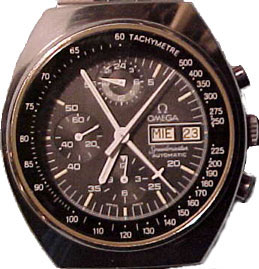
|
|
Omega
Speedmaster Pro Mark IV(a) Ref.
ST176.009
|
Omega
Speedmaster c.1045 Ref. ST176. 0012
|
- At a glance it is easy
to see how a Mark IV(a) could be confused with a
c.1045 Speedmaster. However the layouts of the
Sub-dials are very distinctive. The Mark IV(a) shares
the layout of the Mark III and Speedmaster 125, while
the c.1045 Speedmaster follows the well known layout
of the Lemania 5100 movement that it is based on.
Another quick and easy way to tell the difference is
the Mark IV only has a Date, whereas the c.1045 has a
Day-Date. Most watches that use the Lemania 5100 have
a day-date, however I own several Heuer's that omit
the Day display.
-
- Jussi also pointed out
to me that the Mark IV(a) along with the c.1045 based
ST176.0012 also share a feature with the Speedmaster
125 that none of the other "Marks" do in any of their
variations... The movement, crystal and all, can be
removed from the case as one module. A picture loaded
from Eric Katoso's excellent My
Favorite Omega's
site shows this feature on the 125. From this image
one can see the thickness of this movement:
- The
modularity of certain c.1040
movements...
|

|
--
Photo from Eric Katoso's
My
Favorite
Omega's
site...
|
- Mark
IV(b) Professional:
-
|
Danish
Mark IV Variant / Mark
IV(b)
|
|
 Note:
the "Danish" moniker is due to this piece
being discovered on a Danish website, not
because it was necessarily a model intended
for Denmark... Note:
the "Danish" moniker is due to this piece
being discovered on a Danish website, not
because it was necessarily a model intended
for Denmark...
|
- As I have only seen this
one picture of this variant it is hard to draw any
solid conclusions about this variant. It appears to be
the same watch as a Mark III(b) or a Seamaster c.1040
Cushion case counterpart described above but with a
different dial. The case also appears like it might
have been coated with a PVD-type material to make it a
black cased chronograph that would later become in
vogue with the introduction of Porsche Design "Black
Watches" in the late 1970's although with digital
photography, it's possible that lighting conditions
could cause polished or brushed Stainless Steel to
appear black. This particular watch is posted for sale
on a Web page in Denmark priced at 7,800 Krones, an
amount roughly exchanging to $1,035, at the writing of
this section. Any additional information on this
watch, including someone who could translate Danish
into English would be greatly appreciated!
-
- UPDATE: As of
late Spring/Early Summer of 2003, two additional Mark
IV(b)'s have shown up on the web both in the Denmark
region of Europe. Fortunately Peter Bjerring had the
foresight to contact me and I requested him to contact
John Diethelm with Omega Vintage Information. The
following is John's reply:
-
- Following info
from our archives :
-
- OMEGA -
SEAMASTER
- Mvt. No. 34'680'xxx
(I xxxed out the last three digits --
Chuck)
- Automatic calendar
chronograph of calibre 1040
- Watch reference : ST
176.0007 - stainless steel case: diameter 38 x 38
mm
- Strap lug-size: 22
mm
- Armoured hesalite
glass
- Manufactured and
delivered to Germany in August 1973 !
- Therefore, the
illustrated watch is correct, except the dial
and hands are the wrong ones…
- i.e. they should
belong to another chronograph reference " ST
176.0009 " &endash; cal. 1040 &endash; barrel
shaped steel case with " mineral flat glass" and
having a diameter of 41.5 x 45 mm ! - collection
Speedmaster Professional Mark IV (collection
1974)
- Thus, we can lay to rest
the Mark IV(b) as a misdialed Mark III(b) or Seamaster
c.1040. It does not appear that this configuration is
something that originated from Bienne originally in
the mid-1970's...
-
- Commentary on the
Mark IV:
- The Mark IV(a)
seems to be perhaps slightly less common than the
Mark III(a) and Mark III(b) variants, but more
common than the Mark III(c)'s. If one is
considering purchase of this watch they should also
consider the c.1045 that it is frequently confused
with. The price range on the similar c.1045 should
be slightly less, the 24-Hour register is branched
out from the small seconds and you upgrade to a
Day-Date display from the Date-only display on the
Mark IV. For more information on the
c.1045,
link on over to the
article I've written on c.1045 series of
watches.
All of the c.1045's I have run across have had
non-English day rings installed. An English
Language Day Ring is obtainable and can be swapped
into the watch when it is in for routine
maintenance. I have done this on three of my
c.1045's and will be doing it shortly to the
fourth. The Omega Part number is: 1045-1516 A
(9/97).
- The Mark IV(b)
seems now to be proven as a "Put-Together" as I had
previously supposed. Special Thanks to Peter
Bjerring for contacting me in regards to his
example.
(Special thanks
to Jussi Peltola for his extensive contributions to this
section! -- Chuck)

|
|
Click
on photo to access a 1,280 x 1,028
Scan
|
-
- Mark
V (1984, Central European {¿German
speaking countries?} Market(s)
only):

|
|
Click
on photo to access a 1,280 x
1,028 Scan
|
- After
producing a slew of Mark'ed Speedmasters
in the early to mid 1970's Omega didn't
produce any additional ones for a number
of years. Then in 1984 Omega introduced
the Speedmaster Mark V, using as it's
movement the familiar Omega c.1045
movement based on the Lemania 5100 Calibre
first offered in 1974. With a diameter of
31.0mm and a 8.25mm thickness, this 17
Jewel movement with it's 48 hour power
reserve would be, along with the Valjoux
7750/1 and Zenith El-Primero, one of the
most popular, widely used and successful
automatic chronograph movements ever
produced.
|

|
- The
Speedmaster Mark V as
clearly indicated on
the
dial.
- All
other models using
this case are
variants,
not
Mark
V's.
-
|
|
According
to most literature the Mark V was
only sold in the West German
market. However, Daniel Klooz
emailed me that it was also
marketed in Switzerland, where he
bought his Mark V in 1986. Which
he paid 600 Swiss Francs (Regular
Price was 1200 Swiss Francs). He
mentions that his is a very
accurate and dependable watch and
remains in his
collection...

|
--
c.1045 movement in a
ST176.0014 (1974)
|
|
- The Mark V
consisted of a c.1045 movement that had
not been used in a Omega for a number of
years, incorporated in a modified case
that had been used previously in the
Speedmaster 1982 c.861 model. Both of
these models were marketed only in central
Europe, possibly German speaking countries
only, for a short amount of time, usually
quoted as only one year in each instance.
While the Time Capsule Book states it was
marked only in Germany I find it difficult
to believe that it was available in the
DDR (East Germany) as I think it unlikely
that many East Germans bought or had
access to this model considering the
condition of the DDR's economy at that
time... It was however apparently
available for purchase in Switzerland, and
it is not too much of an intuitive leap to
assume it was also probably available in
Austria.
-
- Mark
V Cased c.861 Variants:
-
- In addition
to the Mark V Speedmaster Omega also
produced at least four variants of this
case with the c.861 movement.
- Satin
finished stainless steel case/bezel with
black dial.
- Satin
finished stainless steel case/bezel with
satin silver dial.
- Satin
finished stainless steel and gold
case/bezel with black dial.
- Satin
finished stainless steel and gold
case/bezel with Gold Dial and Silver
sub-dial's.
- Mark
V Cased c.861 Variant
Showcase:
|

|

|

|

|

|
|
c.861
in a Mark V
|
1)
SS/Black Dial
|
2)
SS/Silver Dial
|
3)
TT/Black Dial
|
4)
TT/TT Dial
|
- The Time
Capsule book lists these c.861 variants as
being offered only in Germany for the year
1982. So in all actuality the Mark V is
based on these earlier models.
However... It should be noted that
the only "true" Speedmaster Mark V
is the one with the c.1045, as it
is indicated as such on it's dial... The
other models are simply 1982 Omega
Speedmaster's. The Time Capsule book lists
the Reference number of only the SS/Silver
Dialed version (Number 2 above) as
ST145.0040. The Reference numbers of the
other variants are currently unknown.
However, I soon expect to know the
Reference number's of Number's 1 and 4
above soon as I have located examples of
each and have purchased them. I remain
searching for an example of the
others.
-
- Commentary
on the Mark V and it's c.861 variants:
-
- Finally!
I have acquired a Speedmaster Mark V, to
go along with my two examples of the c.861
variants (1 and 4 above). Both the Mark V
case with the c.861 movement and the Mark
V case to be the nicest, best engineered
and most modern of the Mark Series cases.
The "c.861 variant" case is actually
subtly different in design and size than
the case used in the Mark V Speedmaster.
The case is thinner and has a couple of
other minor differences due to the
differing dimensions between the c.861 and
the c.1045 movements. As a result the Mark
V's case thickness at 14mm is 1.5mm
thicker than the c.861 Speedmasters using
this basic case design.
-
- In a way
it is also a misnomer to say
that the c.861's are Mark V
variants, as they were produced
prior to the Mark V. In reality the Mark V
is a variant of the c.861's not the other
way around. However, since the c.861's
were never given a distinctive name it is
easier to refer to them as Mark V variants
than the other, proper, way...
- If Omega
were ever to consider offering for sale a
"Modernized" Speedmaster with the c.861
the Mark V case would be a perfect
starting point. It is sleek, modern, smart
looking, comfortable, offers great
protection for the crown and buttons. I'd
probably recommend a inverse treatment
(black background with metallic numerals)
on the Tachy ring for viewability, but
it's a great watch from a wearer's
standpoint.
-
- Note:
Since the initial publication of this
article I have written a
separate article with more details on the
German Market Speedmasters called
"Hooked on
Teutonics".
For more information and scans please
link
over to that
article.
-
|

|
|
Click
on photo to access a 1,280 x 960 pixel
Scan
|
In
Summation...
-
- The Speedmaster Mark
Series is an fascinating group of watches. While it
can be unnerving to consider that it was at one time
possible that Omega may have come close to dropping
the moonwatch in favor of one or more of the Mark
Series, the continuing popularity and classical lines
and looks of the moonwatch doesn't mean that these
watches are unworthy specimens for anyone's
collection. In the end, all of the "Mark" alternatives
to the moonwatch suffered from a problem of thickness.
The only example in the series that comes close to
approaching the thickness of the original moonwatch is
the c.861 variant of the Mark V. It is a very handsome
watch that probably would have sold well if it had
been sold to a wider market than it and it's Mark V
cased relatives were.
-
- Each of the Marks are
very collectable and they show greater variation in
design and style than moonwatches. So if you really
like Speedmaster's and wish to have watches that are
truly different from one another as opposed to
variations on the same theme (like a moonwatch) both
the Mark Series and the c.1045
series of Speedmasters
are a great place to start. The moonwatch is a great
classic design, but it is sometimes difficult to
decide on which of the dozens and dozens of variations
that exist is the right one for you. It is far easier
to do this with one of the Marks. They make great
watches if you don't mind their size.
-
- At this point in time it
appears that for the most part Omega has decided to
focus it's attention in the Speedmaster line to the
Moonwatch and it's variants, various Schumacher
editions, and Triple-Date Automatic Speedmasters. I
suppose that it is hard to argue with success.
However, I for one find the Mark Series and the
parallel line of c.1045 Speedmaster Automatics to be
excellent Chronographs. These Chronographs hearken
back to a time when the watchmakers at Omega were
allowed to think outside of the case and to create new
shapes, styles, features and movements. Sadly, it is
an era that we are not likely to see again anytime
soon. But with whisperings of the Speedmaster
Rattrapante and the recent production of the George
Daniel's Coaxial Escapement, perhaps the time is ripe
for another just around the corner...
-
-
-
Appendix
A: Speedmaster Mark Series
Oddities...
- In addition to the
"Funky Mark II" that I briefly mentioned above there
is one additional Speedmaster that warrants
discussion. Both "Speedmaster Addicted" Wichai
(his words not mine!) and Spudmax in the TZ
Omega Forum made inquiries about the watch pictured in
the Time Capsule Book. In the Time Capsule book there
is a picture in the gatefold of a watch that appears
to be a c.321 Moonwatch with a Mark II Red/Orange/Gray
dial. Unfortunately there is little information about
this particular example. There exists a second example
on KENJI
HOMMA's Speedmaster page...
-
- This example clearly
does not exhibit the Mark II markings.
-
- Thus I see no reason to
state that this watch has any more relation to a Mark
II than any other Moonwatch would.
-
- As for the one in the
Time Capsule Book, which clearly does exhibit the Mark
II text on the dial... I suspect that either a)
Someone cobbled it together (sounds like a fun
project, actually) because they liked the look, b) it
was an Omega experiment to see how this dial would
look on a Moonwatch case.
-
- Wichai said that an
example similar to one of these had appeared on
James
M. Dowling's Rolex site
and was priced around $3,000 before it's image left
the site. A search of Mr. Dowling's site turns up no
such watch up there currently (only a Orange/Red/Gray
Mark II). I have found no information that would lead
me to believe that Omega sold to the public a
Speedmaster with a moonwatch case and a Mark II dial.
It is an oddity and a curiosity but I don't feel that
either is an original factory product. As such it's
value is difficult to determine unless there is some
sort of papers to go along with the watch I wouldn't
pay much more than a comparable Moonwatch.
-
- (Special thanks go
out to both Spudmax and Wichai for their interest and
assistance with this section. While I do not believe
that these oddities belong in the "Mark" mainstream,
they do merit mention and discussion in the context of
this article. -- Chuck)
-
Appendix B: A note to non-native English language
speakers...
-
- In english "Mark" is
often used to denote revised editions, versions,
models or series, etc. In French sometimes a model is
denoted by the suffix bis which means "the second time
around" or second version.
-
- Most of the instances I
can think of off the top of my head involve (wait for
it) automobiles (you should know me by now). Ford
Motor Company has a habit of using Mark II, Mark III,
Mark IV for different versions of cars (like the GT-40
Mark II's that won LeMans 1-2-3 in 1966, the Mark IV
that won LeMans in 1967, etc.), and not just race cars
either... Ford Motor Co.'s Lincoln Division had a
series of cars called the Lincoln Continental Mark II,
III, IV, V, VI, VII, VIII. The Mark VIII was
discontinued past year or two and will most likely be
the last of the "Mark's".
-
- Mark's use as a term to
distinguish differing models in a line of succession
can be likened to that used for Royalty or Popes: King
Edward the VIth, Edward the VIIth..., Pope John-Paul
I, Pope John-Paul II, etc....
-
- (Special thanks go to
Ruckdee C. for this section as he reminded me that the
English language is sometimes anything but logical and
is not an easy language to fathom. Especially if your
native language is anything else! --
Chuck)
-
Acknowledgments...
-
- I would like to thank
once again:
- Jussi Peltola,
Ruckdee C., Spudmax, and Wichai
for their contributions to the article I have
previously mentioned. Jussi also was kind
enough to measure his Mark IV and provide me with it's
thickness for the chart at the beginning of this
article. His contributions to the Mark IV section are
significant and add to the section greatly. I've since
confirmed his measurements
- Mike V. for
photograph of his Mark II, not only does it look
better than my Mark II, he takes a better picture!
- Ruckdee C. for
his picture of his Mark II that is within the Mark II
section... I could say the same thing about his
example and photography skills... They are both better
than mine!
- Daniel Klooz for
his insight on the availability of the Mark V outside
of Germany.
- Chuck A. for
posting a request for information that this article is
intended to fulfill.
- Michael Stein for
spotting a typo which would have causes buckets of
queries sooner or later.
- Chris Santry for
spotting a inconsistency in how I described which
models were "Professional" and which weren't, which
would have likewise caused buckets of queries sooner
or later.
- eieioeieio for the scans of his Red/Orange
Mark II.
- Owain M.Blackwell for forwarding to me an
email from Jean-Luc Miranda of the Omega Museum and
Omega Vintage Information.
- The regulars in the
Omega Forum for their contributions to providing a
place to listen, learn and discuss these fine watches,
and TimeZone for providing such a forum for doing
this.
- Last, but certainly not
least, John R. Diethelm / Public Relations at
Omega.ch who has patiently answered my numerous and
lengthy requests for information and clarification.
John has the patience of a mother of 2-year old
triplets, and the good-cheer of someone who has won a
lottery! It is John and people like him that set Omega
apart from other watch concerns.
-
-
Statement
of rights retained and permissions
granted...
-
- Sources included my own
research, images gleaned from various sources on the
web, Omega Designs book, the Time Capsule book and
other Omega Publications and web sites.
-
- The blue dialed Mark
III(c) variant is scanned directly from the Time
Capsule book, the picture of the Mark IV(b) is from
the Danish site where it is available for purchase,
the picture of the TT/Black dial Mark V variant was
adapted from Eric Katoso's site, the Speedmaster 125
module image is linked from Eric Katoso's site, the
images of the "Odd" Speedmaster Moonwatch c.321 with
the Mark II Style dial is linked from Kenji Homma's
site. Both Mike V. and Ruckdee C. graciously provided
pictures of their Mark II Pro's . Each one adds to
this article. These inclusions are made only for
educational purposes and hence is considered "fair
use" under provisions of the Copyright Act. The author
of the Time Capsule book, Eric Katoso, and Kenji
Homma, retain the rights to the items mentioned above.
My inclusion of them here does not modify their rights
in any way.
-
- Permission is granted
for Damon, Derek Ziglar, Frank N., Ross or Robert Jan
to include within the FAQ's they are writing as long
as I and the others mentioned in this section and the
section above are given credit for their contributions
if used. Permission for personal, educational or
non-commercial use is granted. The author retains all
other rights not specifically mentioned
here.
-
- For all other use please
contact
the author.
-
- Disclaimer:
Opinions are my own and knowing me should be taken
with a grain or two of salt...
- I hope you find this
article informational and entertaining. Please contact
me if you have corrections, additions or other
comments.
-- Chuck
|

|
|
Go!
Speed! Go!
|
|
--
Photo/Art Collage by the Author...
|
|










